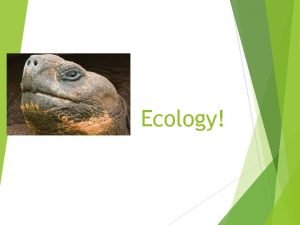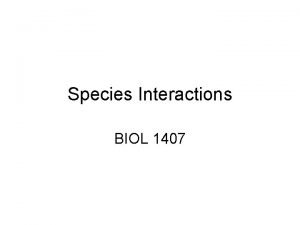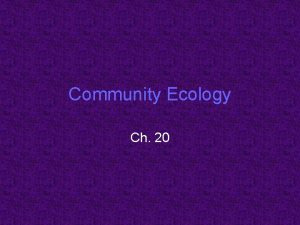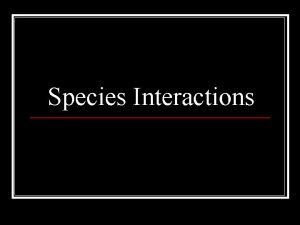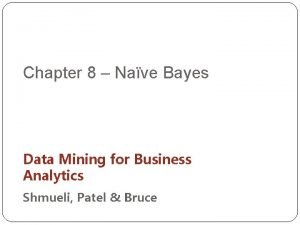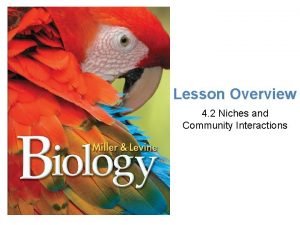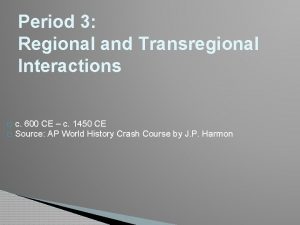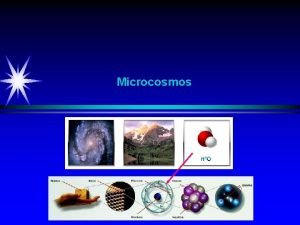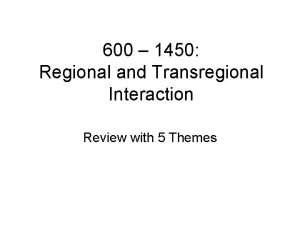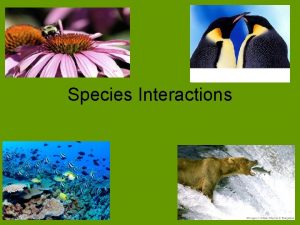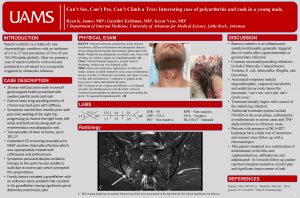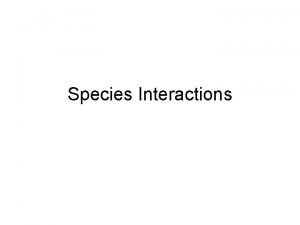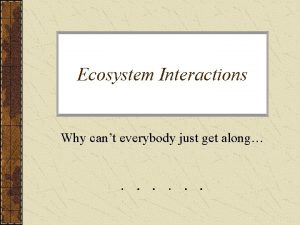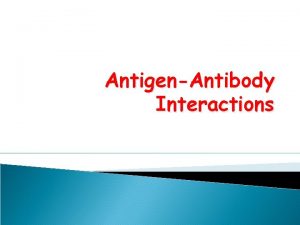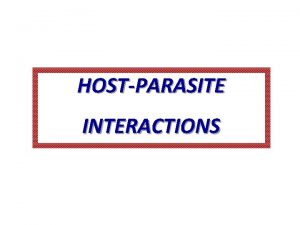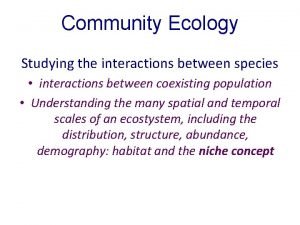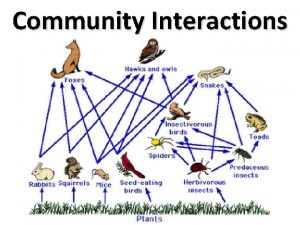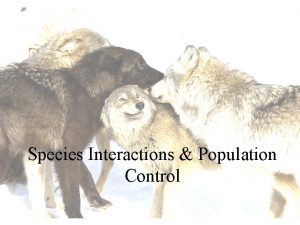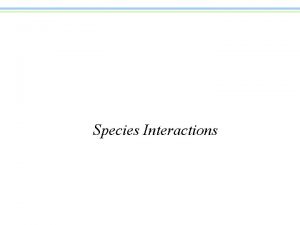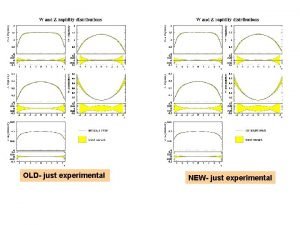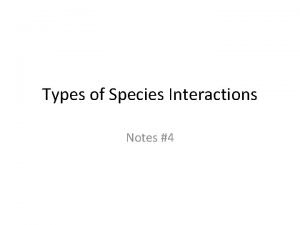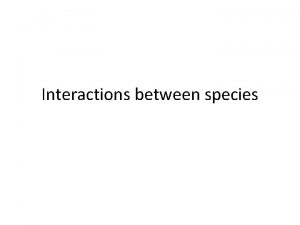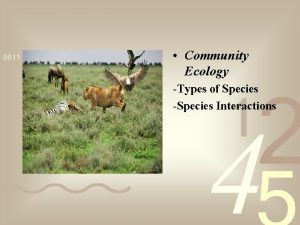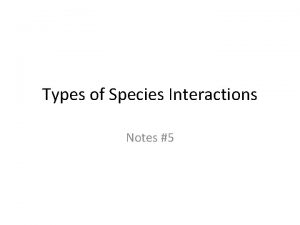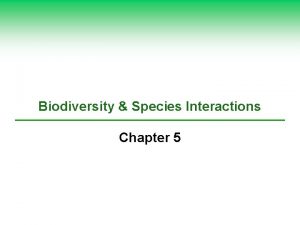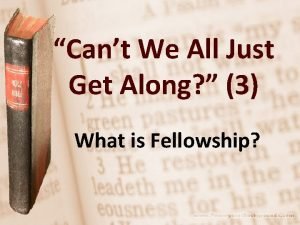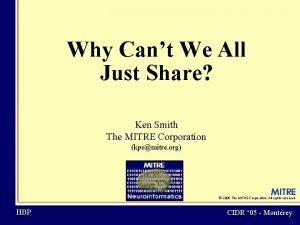SPECIES AND SPECIES INTERACTIONS Cant we all just
























- Slides: 24

SPECIES AND SPECIES INTERACTIONS Can’t we all just get along?

OBJECTIVE SWBAT describe the levels of organization in nature, define “species” and niche, as well as elaborate on the various types of species interactions.

How we came to have the current nomenclature. Humans have always endeavored to classify the natural world and make useful sense of arrangement and relationships. Prior to the work of Carolus Linnaeus, organisms were classified in a multitude of ways that were not systematically developed and maintained. In 1735, Linnaeus released his work in a book titled Systema Naturae. In this book, Linnaeus outlined a method of grouping things in a methodical and organized way. This method is called binomial nomenclature and the names used are Genus and species.

From the broad to the narrow Genus refers to the general characteristics displayed by an organism (color, size, habitat, etc. ). Species refers to the more specific characteristics displayed, and often is used to honor the person responsible for identification. Genus is capitalized and species is not. When typed, the two words are italicized. When hand-written, the two words are underlined.

Linnaeus expands his system Linnaeus grouped nature into 3 kingdoms – mineral, vegetable, and animal. As more organisms were added to the vegetable and animal kingdoms, the need arose to further distinguish one from another. To accomplish this, Linnaeus added variety as a subgroup of species, as well as class and order above Genus. The two kingdoms of organisms, vegetable and animal were expanded in subsequent years to include additional discoveries which did not fit neatly into the existing framework.

Expanding the scope Linnaeus Haeckel Chatton Copeland Whittaker Woese Cavalier. Smith 1735 1866 1925 1938 1969 1990 1998 2 Kingdoms 3 Kingdoms 2 Empires 4 Kingdoms 5 Kingdoms 3 Domains 6 Kingdoms Archaea Archebacteri a Prokaryota Eukaryota Monera Bacteria Eubacteria Protista Eukarya Protista Animalia Animalia Plantae Vegetabilia Plantae Fungii

Taxonomic Classification Kingdom - Animalia Phylum - Chordata Class - Mammalia Order - Primates Family - Hominidae Genus - Homo Species - sapiens

Niche Niche is defined as the role a species plays in an ecosystem. This involves everything the organism does to survive and reproduce. The Fundamental niche is the full potential an organism is capable of, under ideal circumstances. The Realized niche is what an organism actually accomplishes due to limiting factors. Limiting factors are things like competition, predation, illness, disease, and other environmental factors. Let’s identify your fundamental niche, realized niche, and your limiting factors.

Species A species is defined as a group of organisms close enough genetically to produce viable offspring. In other words, their offspring are also able to produce offspring.

Species in an ecosystem Native species are indigenous to an area and, generally, well adapted to survive given climatic factors. Non-native, introduced, invasive, exotic, and alien species are often brought into an area and they have been known to disrupt the ecosystem, sometimes with catastrophic results. Crassostrea virginica is the native oyster found in the Chesapeake Bay. Currently, it is at dangerously low population levels due to overharvesting and disease. Crassostrea ariakensis has been identified as a possible replacement to the native oyster. Concern has been raised about how it may impact

Roles of species Indicator species – illustrate damage to the ecosystem. Songbird populations are the first to dwindle when forests are removed. Trout populations indicate damage done to freshwater streams. Trout prefer cold, highly oxygenated water. What happens to water when we dam it? Keystone species – their niche is larger than would be expected based on their abundance or biomass. A classic example is the lowly dung beetle. Were it not for the movement of nutrients in dung by these organisms, entire eco-systems would

Breeding Intra-specific breeding is the result of two organisms of the same species. The resultant offspring is an member of the same species as the parents. Inter-specific breeding is the result of two organisms of differing species. The resultant is called a hybrid and displays, to varying degrees, attributes of both parents. A male donkey and a female horse may produce a mule. The offspring of the opposite combination is a hinny and is far less common. Typically, a hybrid is sterile. But, recent cases demonstrate this is not always the case.

Other Examples of Hybrids Zebroid Wholphin Killer bee

Chemical Messages Organisms use hormones to regulate internal conditions. Typically, these processes involve a negative feedback loop. Hormones are chemical messages which stay inside an organism’s body. Many organisms utilize pheromones to attract a potential mate. Pheromones are chemical messages which are released from an organism’s body. Pheromones are specific to a species, and other species do not respond to their effect.

Trophic Levels Producers – Autotrophs, utilize light (or chemical) energy to create macromolecules, use these macromolecules for their own needs as well as provide them for other trophic levels. Consumers – Heterotrophs, consume other organisms to avail themselves of energy � Primary – Herbivores, consume only plant material � Secondary – Omnivores, typically consume both plant material and primary consumers � Tertiary – Carnivores, typically consume only other consumers � Why are there rarely, if ever, quaternary consumers?

Trophic Levels (cont. ) Scavengers – feed on the remains of organisms killed by others, in essence, they steal their food Detritovores – organisms which feed on the decaying material and of dead organisms or feces, a good example would be earthworms Decomposers/Saprotrophs – organisms which complete the breakdown (decomposition) of organic material, they often absorb nutrients, rather than consume them, examples include bacteria and fungii

Pyramid of Numbers

Pyramid of Numbers (cont. ) Sometimes, the pyramid shape is not truly applicable.

Pyramid of Biomass is the mass of the biological organisms living in an ecosystem at any given time.

Pyramid of Energy

So, where should we feed? Energetically, it makes 10 x more sense to feed at the primary consumer level. Most humans in developing nations tend toward a herbivorous diet. However, humans in developed nations have increasingly turned to meat as an energy source. So, why do we tend toward more of a carnivorous diet?

Inter-specific competition and Predation Interference competition occurs when one species limits the ability of another species access to a resource. Hummingbirds are known to aggressively chase off other bird species from flowers. Exploitation competition occurs when one species is more efficient in exploiting an equally available resource. Lions and cheetahs often compete for gazelles on the African plain, with lions, generally, being faster. Predation occurs when one species (predator) feeds directly on all or part of an organism of a differing species. Multitudes of examples come to mind.

Defenses against predation Camouflage – an appearance which allows an organism to blend in with its surroundings. Chemical warfare – an organism is protected by a chemical it produces which discourages predators. Warning coloration – many badsmelling, bad-tasting organisms have survived with bright coloration which, otherwise, would make them likely prey. Mimicry – enjoying the benefit of resembling a distasteful or toxic organism. Physical displays – making itself appear to be larger and more threatening is often employed as a defense.

Symbiotic relationships Mutualism – (+, +) both organisms benefit from being participants in the relationship. Plants and pollinators are a great example. Commensalism – (+, 0) one organism benefits and the other is (seemingly) unaffected. Clownfish and sea anemone. Parasitism – (+, -) one organism benefits and the other is harmed. Parasitic wasps and tapeworms.
 If you don't measure it you can't improve it
If you don't measure it you can't improve it Can't manage what you don't measure
Can't manage what you don't measure Niches biology
Niches biology Symbiosis and species interactions keystone webquest
Symbiosis and species interactions keystone webquest Species interaction
Species interaction Wikimedia
Wikimedia Section 20-1 review species interactions
Section 20-1 review species interactions 5 major types of species interactions
5 major types of species interactions Describe the dream that romeo has just had
Describe the dream that romeo has just had Mountain lion keystone species
Mountain lion keystone species Name three lines
Name three lines Interactions between ais and internal and external parties
Interactions between ais and internal and external parties Quantitative vs qualitative
Quantitative vs qualitative Unit 5 macroeconomics lesson 2 activity 45 answer key
Unit 5 macroeconomics lesson 2 activity 45 answer key The properties and interactions of magnets are called
The properties and interactions of magnets are called Sphere interactions examples
Sphere interactions examples Modular vs integral product architecture
Modular vs integral product architecture Factors that influence
Factors that influence Naive bayes pays attention to complex interactions and
Naive bayes pays attention to complex interactions and Integral vs modular design
Integral vs modular design Niches and community interactions
Niches and community interactions Regional and transregional interactions
Regional and transregional interactions Fundamental particles and interactions
Fundamental particles and interactions Regional and transregional interactions
Regional and transregional interactions Versine of curve
Versine of curve



